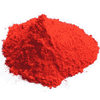
Azorubine
High risk
Alternate Names:
- carmoisine
- ci 14720
- ci food red 3
- fd&c red 10
Info from food-info.net:
- Description:
- Function:
- Red food colour. Very soluble in water.
- Origin:
- Synthetic azo dye. See here for a background on azo dyes.
- Side effects:
- Since it is an azo dye, it may elicit intolerance in people intolerant to salicylates. Additionally, it is a histamine liberator, and may intensify symptoms of asthma. In combination with benzoates, it is also implicated in hyperactivity in children.
Dietary restrictions:- None; E122 can be consumed by all religious groups, vegans and vegetarians.
Acceptable daily intake:- Up to 4 mg/kg body weight.
Status:- Unknown
Info from proe.info:
- Description:
- Benefits:
- Due to its synthetic origin, the E122 additive is not characteristic of living organisms. There is no scientific evidence of any benefits of Azorubine at the moment.
- General:
- The Azorubine (carmoisine, E122 food additive) belongs to the group of azo colorants - synthetic colorants of red tints. The chemical formula of the E122 additive: C20H12N2Na2O7S2. Azorubine belongs to coal tar derivatives. The E122 food coloring is usually supplied in the form of edetate disodium which is a powder of a red to dark maroon color. The E122 additive can be used for coloring products that are heat-treated after fermentation. E122 food coloring has good luminosity resistance.
- Harm:
- As a result of numerous studies of the E122 food additive, many possible negative effects on the human body were revealed. Consumption of carmoisine in food may lead to allergic reactions in the form of skin rashes. People suffering from bronchial asthma and intolerance to anti-inflammatory medications and fever relievers (aspirin) should be especially careful while consuming products containing the E122 colorant. Recent studies conducted by the University of Southampton on behalf of the UK Government Food Standards Agency (FSA) have shown that consumption of products containing the E122 additive leads to increased hyperactivity and reduced concentration in children. The World Health Organization, together with FAO, has set the maximum daily intake of Azorubine at 4 mg per 1 kg of body weight.
- Legal:
- As a result of research on food additives, it was decided to ban the use of six colorants in the UK since 2010. The ban also included the E122 additive. The E122 colorant was also banned in Japan, Canada, Norway, Austria, Sweden and the United States. In some countries, the E122 additive is classified as a carcinogen, which increases the likelihood of cancer. The E122 food coloring additive is allowed for use in the food industry of Russia, Ukraine and some EU countries.
- Use:
- In the food industry, the E122 additive is used for coloring products in red tints. The most common the E122 additive can be found in jams, syrups, marmalades, confectionery products, beverages and juices of red color. Quite often, the E122 color is used in mixtures with other colors to give products complex colors (green, brown, purple, etc.). Besides the food industry, Azorubine (E122 colorant) is used in cosmetology and perfumery.
- Links:
- Unknown
Dietary restrictions:- Unknown
Acceptable daily intake:- Unknown
Status:- Unknown
ninamvseeno.org -- site no longer live
- Description:
- Banned in Canada, Japan, Norway, Sweden, Austria and USA. Reactions in asthmatics and people allergic to aspirin, hyperactivity in children, higher occurrence of tumors in animals has been proven. It is slowly being phased out, products with this additive will have to be specially labeled in the EU.
Dietary restrictions:- Unknown
Acceptable daily intake:- 4,000 mg/kg body weight/day (EFSA, 2009)
Status:- Approved in the EU. Undergoing a voluntary phase-out in the UK. Currently banned in Canada, Japan, Norway, USA. EU currently evaluating health risks.
References: